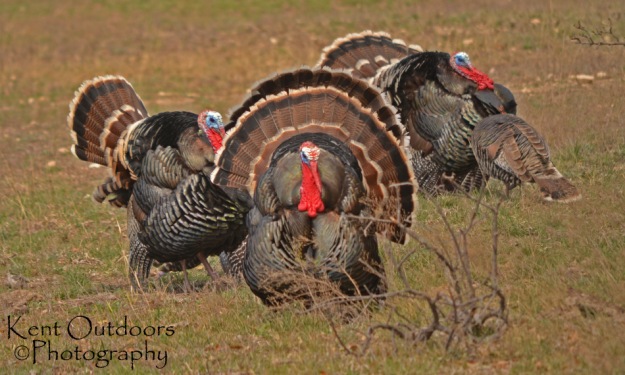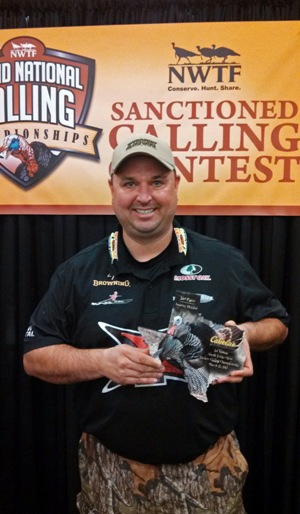J.J. Kent Loves to Guide and to Hunt Rio Grande Gobblers

Editor’s Note: J.J. Kent owns Kent Outdoors in Pottsboro, Texas about one hour north of Dallas where his hunters have about 20,000 acres to chase turkeys like he has for 32 years. The Regional Mossy Oak Pro Staff Manager for Texas, he's a Pro Staffer for Zink Calls and Avian-X decoys. “My wardrobe includes Mossy Oak Obsession, Mossy Oak Bottomland and Mossy Oak Break-Up Infinity,” Kent says. “Often, I’ll mix and match my camo, depending on where I’m hunting.” He especially likes the Lost Lady diaphragm call and the Power Hen slate call and shoots a Browning shotgun with a Patternmaster choke tube and Hevi-Shot Magnum blend #5, #6 and #7 shot shells.
We hunt Rio Grande gobblers here at Kent Outdoors and usually take about 15 - 20 hunters per season. We try to provide the richest turkey-hunting experiences that our hunters can have. When sportsmen show up who have hunted many eastern wild turkeys and go on their first Rio Grande hunt, they tell me that the Rio Grande gobblers are much more vocal than the easterns. What everyone seems to enjoy about the Rio Grande gobblers is when you locate one and start gobbling to him, that gobbler will sound-off. Often, he’ll continue to gobble all the way in to the gun.
 The Rio Grande gobbler is much like a high school cheerleader who wants everyone to be as excited as she is and everybody in the crowd to notice her cheering. I enjoy guiding turkey hunters because nothing’s more exciting than getting a big Rio Grande gobbler to sound-off every time I touch him with a turkey call, and watch him come in strutting, spitting, drumming and fighting with the decoys. Something I've observed about the Rio Grande is that if you have a big, ole, boss gobbler on your property, he’ll find a hilltop roost by himself and fly down to the top of the hill to rule his domain. The jakes and the 2- and 3-year-old gobblers often will roost together in bachelor groups and run around with each other. Just before the season arrives, the hens will flock together, and the gobblers will flock together. But as the mating season comes in, those bachelor groups of gobblers split-up, and the big flocks of hens will split off into smaller flocks.
The Rio Grande gobbler is much like a high school cheerleader who wants everyone to be as excited as she is and everybody in the crowd to notice her cheering. I enjoy guiding turkey hunters because nothing’s more exciting than getting a big Rio Grande gobbler to sound-off every time I touch him with a turkey call, and watch him come in strutting, spitting, drumming and fighting with the decoys. Something I've observed about the Rio Grande is that if you have a big, ole, boss gobbler on your property, he’ll find a hilltop roost by himself and fly down to the top of the hill to rule his domain. The jakes and the 2- and 3-year-old gobblers often will roost together in bachelor groups and run around with each other. Just before the season arrives, the hens will flock together, and the gobblers will flock together. But as the mating season comes in, those bachelor groups of gobblers split-up, and the big flocks of hens will split off into smaller flocks.
Before the season one year, I saw about 300 turkeys on the roost at one place where I hunt. Fifty of those turkeys were gobblers, and the rest were hens and jakes. On our property, I do fully-guided hunts since the turkey hunts have a special place in my heart, I like to take out each one of our hunters.
I’m often asked, “What’s the biggest mistake your turkey hunters make?” For the first few years, we’d run and gun for gobblers with our hunters. We’d hear a turkey gobble, try to get close to him, sit in the brush and attempt to call in the turkey. Because the terrain is so open in our part of Texas, we soon realized that the least little movement would spook a gobbler. Even though our hunters would try to sit as still as they could, they’d still make some type of movement that would result in spooking the turkey, and the gobbler wouldn’t come in to us.
Something I've learned about Rio Grande turkeys is that they’re the smartest yet the dumbest gobblers you'll ever hunt. Before or after the season, you can be walking around, and a turkey may walk right up to you. But when turkey season arrives, these gobblers graduate from being dumb to obtaining their Ph.D. in hunter dodging. Texas Parks and Wildlife did a study that showed that either 1 out of 10 or 1 out of 15 turkey hunters were successful when they went hunting. Last year we started using Ameristep pop-up blinds (http://ameristep.com) to hide better and hopefully have more success. When we hunt turkeys, we use a two-blind system.
Tomorrow: Why J.J. Kent Likes a Two Blind Set-Up and to Set-Up Decoys at 12 to 14 Yards




























